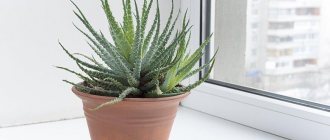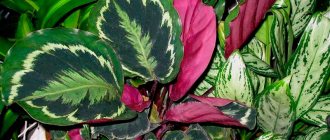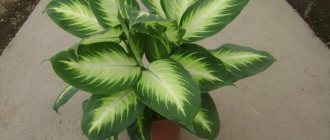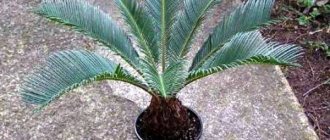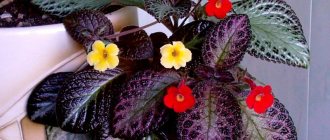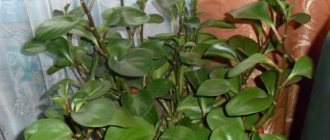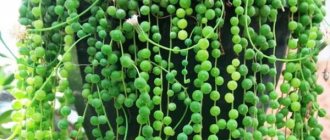What do cactus seeds look like?
In addition, this is the cheapest option for creating your own collection.
Of course, you can buy already grown plants, but here a novice cactus grower will face many pitfalls and disappointments. Purchased specimens may be affected by pests and rot, and cacti grown with fertilizers stubbornly refuse to grow in ordinary soil. In addition, cacti that have been in stores for a long time with a lack of light often have stems that are hopelessly damaged. Finally, the attitude towards these cacti will be completely different than towards plants grown by yourself. Before planting cacti, you need to get the seeds from somewhere. Purchasing planting material will not cause much difficulty. They can be bought in clubs for cactus lovers, borrowed from friends, ordered from private catalogs, and finally purchased via the Internet. The rest of the seed is filled with a nutrient substance called endosperm. On the shell you can distinguish a hilum - the place where the seed is attached and a micropyle - a narrow channel through which the pollen tube penetrates and fertilization occurs. When seeds germinate, the root elongates and penetrates into the soil. At the beginning of germination, all cells of the embryo divide, but after the formation of the seedling, cell division is localized at the tips of the shoot and root.
The seeds of rebutia, ailostera and some other genera have a short life. The period for germination of cacti from such seeds is limited to approximately one year. Conversely, in representatives of the genus Cereus and Mammillaria, the lifespan of seeds can reach 7-9 years. Longer-living seeds are also known. In addition to biological reasons, the lifespan of seeds depends on their storage conditions. There are two independent rules for storing seeds: 1) with an increase in water in seeds by 1% (with an optimum of 5-14%), their lifespan is reduced by 2 times. At the same time, below the optimum, oxidation of seed fats occurs, above the optimum, fungal damage occurs; 2) with an increase in temperature for every 5 °C (in the range of 0-50 °C), the lifespan of seeds is also reduced by 2 times. In other words, so that cactus seeds do not lose their viability, it is advisable to store them in the optimal range of temperatures and humidity, without changing these parameters if possible. For cactus seeds, a good place to store seeds is on the shelf on the door of your home refrigerator.
Next, you will learn how to plant cactus seeds and how to care for the sprouts.
How and in what cases should it be used?
Prickly pear extract can be used for the prevention and treatment of diseases, as well as in cosmetic care products. Depending on the scope of application, there are different methods and recipes.
- For oral use, mix the vizhimka with water in a ratio of 1/10. This composition helps with weight loss, and is also used as a medicine in the treatment of acute respiratory viral infections and gastrointestinal disorders. Don't forget to consult your doctor.
- To combat a hangover, dissolve a tablespoon of extract in a glass of water.
- To cure skin problems, add oil or water to the squeeze and moisten the compress with the resulting mixture.
- For rheumatism, compresses with prickly pear juice are applied to sore spots.
Prickly pear extract is used in products for the care of problematic, mature and aging skin. It is especially effective in treating acne. Also, prickly pear juice, diluted with water or oil, is used to whiten the skin.
Used for the production of sunscreens. Extract-based shampoos prevent dandruff.
Beneficial features
Prickly pear is not only a cactus, but also a very useful plant. It contains a huge amount of useful elements and vitamins. For example, stems contain amino acids, protein, starch and much more. From the vitamin group, we can note the presence of vitamins A, B (1,2,3) and C.
Not only the stems contain a lot of useful things, but also the fruits of Opuntia. They are tasty, juicy and rich in phosphorus, magnesium, protein and calcium, as well as glucose.
Thanks to all this, many medicines are produced from Opuntia that help fight various diseases, for example, disorders of the central nervous system, cardiovascular diseases, and diabetes. In addition, with the help of Opuntia, people successfully fight excess weight, skin diseases, rheumatism, etc.
In addition to medicines, glue, oil (something like sunflower or olive), detergents and cleaning products, as well as various cosmetics, which, by the way, are not so cheap, are made from Opuntia.
What a useful plant!
Cactus pots
Cacti are quite demanding on the container in which they will grow. The size of the pot should match the root system of the cactus. To choose the right pot, you need to remove the cactus from the old container, carefully straighten the roots and inspect the root system. In some cacti, the roots are better developed in the upper part and are not very long, then the pot should be wide enough, but not deep. In other cacti, the roots grow in length, especially if the root system has a main taproot, then the pot should be deep, but not wide. In any case, the volume of a pot or other container for planting should not greatly exceed the volume of the root system in a straightened form, but it must be taken into account that some space in the pot will be taken up by drainage.
An incorrectly selected pot - it is too large, the cactus will grow in it too slowly, all you have to do is admire the decorative stones.
Properly selected pot, commensurate with the root system. In addition, in a properly selected pot, the cactus is less likely to suffer from excess moisture.
If the cactus is sick or damaged in some way, then the dishes should be slightly smaller in size than the volume of the root system. Also, when choosing a container, you should take into account the growth pattern of cacti. For example, mammillaria form many children, and in one pot there are many plants, so they need wider pots, but not deep ones. But for Ariocarpus, for example, the container should be deeper than wide.
What material the container for growing a cactus will be made of is a matter of taste. Cacti are usually grown in plastic pots, but they can also be grown in clay pots, plastic yogurt cups, ceramic cups, coconut shells, etc. It is undesirable to grow cacti only in metal containers, which can rust, and this will adversely affect the plant. If there are a lot of cacti and the collection is growing, then it is quite convenient to plant the cacti in square or rectangular containers, which are then placed easily and tightly together on a common tray; this makes it easier to carry the cacti; the tightly arranged pots occupy a stable position. Only the frequency of watering depends on what material the container is made of. In plastic dishes, the earth retains moisture longer than in clay ones.
Another condition for containers for cacti is drainage holes. We can say that this is a mandatory condition, since cacti really do not like stagnant water in the pot (especially epiphytes). Water that remains in the roots can lead to rotting and death of the plant.
What does the plant look like and how does it bloom?
At home, prickly pear grows up to 1.5 m, but blooms rarely and reluctantly. There are also low-growing species from 15 to 30 cm.
- The stem is jointed, dark green. It consists of flattened shoots (cladodes) of a teardrop shape. At the top of the cladode, from 2 to 5 shoots grow - thus, the prickly pear branches in the form of a bush.
- The leaves are rudimentary, succulent, awl-shaped, up to 1 cm long, appearing in the areoles of young cladodes. They are pressed to the surface of the shoots and die off over time.
- The root system is superficial, fibrous.
- The flowers are funnel-shaped, single, multi-petaled, wide-open, from 3 to 6 cm in diameter. Colored in yellow, orange, red, pink and white. The stamens react to touch and immediately curl. Buds are formed along the edges of the cladodes. The flowering period is from April to August. In different species - from a week to 4 months. Only adult plants bloom from 4-5 years of age.
- The fruits are fleshy, weighing from 70 to 200 g, 5-12 cm long. They ripen from the end of July. The pulp is juicy, tender, watery. The consistency and taste is similar to ripe, sweet gooseberries and kiwi. Ripe fruits have pink-orange, red, and purple skin.
- All types of prickly pear, in addition to spines, have bundles of glochidia, which are located in the axillary buds of the stem and on the fruits.
How to determine the names of cacti species
Cacti: types and varieties... What is the name of the cactus growing in your home? Description of species and names of cacti, many of them bloom with original flowers...
In what natural conditions a particular species grows can be found in specialized literature and on the Internet. But you can find information only if you know the correct name of the cactus. Therefore, before purchasing, you should try to find out at least the generic name of the plant you like...
The extensive family of Cacti (Cactaceae Juss.), comprising more than 3000 species, is divided by taxonomists into 3 subfamilies that differ in their structure.
Pereskiaceae (Pereskioideae Schum.) - representatives of this subfamily have round stems with flat leaves, in the axils of which there are spines, often straight and hard. They bloom with single flowers on peduncles, although sometimes they form an inflorescence. The fruits of many Pereskieves are edible. Seeds with a thin, fragile black shell. The subfamily includes only 3 genera and about 30 species, of which 20 species are cacti with normally developed leaves.
- Genus Pereskia - Pereskia (Plum.) Mill. There are 8 species and 4 varieties of shrub-like cacti. In greenhouses, Pereskia spinosa and its variety are most often bred - (var. godseffiana (Sand.) Knuth. with a red-violet underside of the leaf.
- Genus Rhodocactus - Rhodocactus (from the Greek “rhodo” - “rose”) (Berger) Knuth. About 13 species are known, distributed in Mexico, the West Indies, and South America. R. bleo (N.B. et K.) Knuth is most often cultivated in greenhouses. The latter grows quickly and blooms even when grown in pots.
Some species and varieties do not develop enough in indoor conditions and almost do not bloom, so they are most often used for grafting profusely flowering zygocacti and others onto them.
Opuntiaceae (Opuntioideae Schum.) - most representatives have small, succulent, and quick-falling leaves. In the areoles, in addition to the spines, there are special bunches of tiny, very fragile jagged bristles - glochidia, which are considered modified leaves. They are absent in other subfamilies. The stems are succulent and jointed. The segments of different species are different in shape: flat-shaped, cylindrical, thickened, potato-shaped, etc. Flowers are most often regular in shape, single and large, of various colors (yellow, white, red, carmine). The fruits of most prickly pears are edible. Seeds with a hard shell and a white hard auricle. The subfamily includes 16 genera and over 500 species.
Cereus (Cereoideae Schum.) - plants without leaves and glochidia. This is the largest subfamily of cacti, which includes the most diverse cacti in appearance, giant and dwarf forms. The shape and structure of the stem of representatives of this subfamily can be very diverse: snake-like, candle-shaped, cylindrical, spherical, tuberous, with papillae. Many of them have spines. The fruits of some types of cacti are edible. Seeds with a fragile shell and aperture. They mainly grow in arid areas and only some species are found in dark tropical forests, as epiphytic plants living in crevices of the bark, on the trunks of old trees in a very humid and warm climate (Selenicereus, Hylocereus, etc.)
The conditions for keeping cacti depend not only on whether it belongs to a certain genus or species, but largely on its habitat in nature. In this regard, the diverse cactus family is divided into several groups: cacti of wet and dry forests, grassy plains, sea coasts, as well as mountains and deserts.
Cacti and succulents Often our interest is awakened by a single specimen received as a gift or brought from a trip as a souvenir. And as soon as you fix your gaze on these wonders, one species may not be enough...
see “Photos of cacti and succulents”
Homeland of the succulent
In their natural environment, prickly pears are widespread in North and South America, including the West Indies. The main mecca of these large succulents is Mexico, where almost half of all varieties of prickly pear grow.
Possessing high adaptive properties, some types of prickly pear have spread to various areas, almost all over the world, where the climate is tropical and subtropical. Moreover, some of the neophytes turned out to be very aggressive, literally flooding the local flora. To combat cacti that felt at home in new territories, in some regions it was necessary to use biological agents.
How to make a cactus bloom so that cacti bloom
While some cacti will bloom at a fairly young age, there are others, such as prickly pear and cereus, that are more difficult to get into bloom. In order for cacti to bloom, they need to create conditions close to their natural habitat. Next, we consider how to make a cactus bloom at home using simple methods.
In a large number of cases, cacti are able to bloom indoors by the time they are three or four years old. They will bloom every year, usually in the spring. You can also collect a small collection of cacti that bloom at different times throughout the year.
The secret is that most cacti can only bloom on new growth. In order for growth to appear, cacti will require summer care and relative rest in winter, as described in the Secrets of Success section. You also need to remember that flowering is encouraged by growing in a slightly cramped pot.
Propagation of cacti by seeds
Cactus propagation by seeds is not always effective. In many species of these plants, the seeds are very small, germinate poorly or are very capricious and require strict adherence to many conditions - from temperature, light and humidity to soil composition.
But if your cactus seeds are fresh, large, healthy and you are confident in your skills and abilities as a gardener, you can try to master this procedure.
Cactus seeds can be sown in the ground starting from February-March. To disinfect them before sowing, it is better to soak them for a short time (8-10 hours) in a slightly pink solution of potassium permanganate.
Soil for cacti is suitable from a mixture of peat and coarse sand (2:1), pre-calcined in the oven or spilled with boiling water. A layer of drainage must be poured onto the bottom of a disinfected small pot and only then filled with soil mixture.
Cactus seeds are laid directly on the surface of well-moistened and slightly compacted soil at a distance of at least 2 cm from each other. It is not necessary to sprinkle them with soil on top - this can only be done for large seeds.
The container with the seeds is covered with glass or film and placed in the warmest place, remembering to ensure that condensation does not accumulate on the inner surface of the shelter. The night temperature in such a greenhouse should be several degrees lower than the daytime temperature.
Shoots will have to wait from several days to several weeks, depending on the chosen type of cactus. As soon as the sprouts appear, they need to be provided with a sufficient amount of light; it is recommended to move the film or glass from time to time so that there is a constant flow of fresh air, and then remove it completely. Of course, a place with young growing cacti should be protected from drafts and direct burning sunlight.
As for the issue of watering seedlings, you need to be very careful and careful - both a lack and an excess of moisture are equally destructive for growing cacti. The soil should ideally be slightly moist at all times, but not wet.
Grown cacti, which have begun to develop thorns, can be transplanted into individual pots - the plants are carefully transferred with a lump of near-root soil, in no case burying the root collars when planting.
Opuntia Reproduction
Possibly in two ways: cuttings and seeds. Cuttings are used more often than propagation by seeds. In the same way, the cactus develops new territories in the wild. But let's look at both methods:
When propagated by seeds
This results in a much larger number of young plants of approximately the same age. The second advantage of this method is the good health of the young animals. Opuntia seeds can be planted within two years from the date of collection. As was said, cactus seeds are covered with a hard shell, and in order for the sprout to break through it, you need to perform scarification:
Scarification is stimulating plant growth by breaking the integrity of the hard shell of seeds mechanically or by exposure to a certain temperature.
- A small part of the crust is removed from any edge of the seed by grinding it off with a file or sandpaper. After removing part of the cork layer, you will see a black “dot” - a grain in the center, it is important not to damage it;
- Soak the seeds in a weak solution of potassium permanganate for 1-2 hours;
- Place the planting material in distilled water for a day;
- Place in a porous, damp material such as padding polyester or foam rubber, and then in a plastic bag and leave at a temperature of 20-25 degrees for germination;
- The seeds will germinate within 10-20 days, this happens unevenly, check them periodically.
Seeds with sprouts are planted immediately in separate containers to a depth of 1-1.5 cm. The soil is prepared from charcoal, rotted leaf soil, crushed expanded clay, and coarse sand in equal parts. The composition should be light and breathable. Do not forget to lay out a drainage layer at the bottom. Greenhouse conditions are created until the first two leaves and a small “cactus” appear between them. This is followed by diving (deepening) to the growth point of the first two leaves and abandoning greenhouse conditions. Subsequent care does not differ from the conditions for an adult plant.
Before diving, the lighting is kept plentiful, but without direct sunlight, so as not to damage the first two leaves of the plant.
It is possible to germinate Opuntia seeds directly in the substrate. This method differs from the previous one in that after mechanical “opening” and disinfection with potassium permanganate, the seeds are placed in wet river sand (which is calcined before this). For germination, greenhouse conditions are created with a temperature of 20-25 degrees Celsius, and when shoots appear, the sprouts are transplanted into individual containers. The disadvantage of this method will be poor visualization of the appearance of sprouts at the initial stage of Opuntia growth.
When grown by seeds, the central stem first grows cylindrical in shape, and only then, increasing in diameter, becomes flat.
For propagation by cuttings
Select small healthy branches (babies) of the prickly pear and cut them with a sharp knife. Dry for 3-4 days. After the cut has healed and the shoot has become a little soft (dried), you can begin planting.
For this method of reproduction, the end of spring - the beginning of summer is suitable, at this time the temperature is favorable 20-25 degrees, and sap flow is at a high level.
The pot is chosen to be small in size, with a drainage layer 1-2 cm thick at the bottom. The soil is suitable in the same way as when planting sprouted seeds (found in the previous subsection). It is not necessary to deepen the sprout much, this is only necessary so that it stands more or less vertically. The soil is slightly moistened and the seedling is left in a dark place for rooting. Watering the cuttings should be done a little more often than an adult plant, by 25 percent, but also after the top layer has dried to a depth of 2-3 cm. For more reliable root formation, you can make a mini greenhouse, covering it with a plastic bag or glass jar.
Seasonal care features
Spring
This is the time when the cactus comes out of dormancy and prepares to please the owner with amazingly beautiful flowers. Gradually increase the air temperature to optimal levels, resume the application of fertilizers and organize regular, but not too abundant irrigation.
Summer
Caring for cacti of this variety in the summer comes down to organizing adequate lighting, nutrition and irrigation.
Autumn
Gradually they begin to prepare the mammillaria for the rest period. Reduce the number of fertilizers and soil moisture. Organize light shading.
Winter
The quality of the growing season in the new season depends on proper rest during the winter period. Fertilizer application is stopped altogether, watering is carried out rarely, as the soil dries out. The temperature in the room where the succulent will overwinter should not be below 15 degrees, otherwise the plant will get sick and will not enjoy abundant flowering when spring arrives.
Prickly pear cactus cultivation and care
Cactus in a pot: examples of proper planting and options for several flowers
Choosing a location When a cactus takes root, it grows in one place for a very long time. An open, sunny area without drafts suits him. On an alpine hill, prickly pear will look and feel amazing. You just need to plant it in the center of the alpine hill. Since prickly pear is a succulent plant with special tissues in which the necessary supply of water is formed, heat is necessary in the summer, and in winter irreversible processes can occur from excess dampness. To avoid excesses, drainage is necessary.
Soil Opuntia, with its rapid growth, feels excellent on soil with a slightly acidic reaction, loosened, with the addition of sand, small pebbles and expanded clay gravel. If the root collar is covered with small pebbles, then when watering the water will not stagnate, which means that rotting processes will not occur. The baby is also watered separately. Over the summer, the prickly pear will grow and increase in volume.
First wintering Having left the cactus to winter in the open air, it is necessary to cover it with dead wood and pine needles. During the winter the plant becomes deformed, but with the onset of spring it will be reborn. By summer, buds will appear on the stronger plant. In sunlight they will open up and delight you with gorgeous blooms.
Watering and fertilizers The plant needs constant, abundant watering. Although a certain amount of water has accumulated in the tissues, if watering is not sufficient, the prickly pear will begin to wither. Having received a sufficient amount of moisture, it will restore its previous appearance. At the end of summer, the amount of watering is reduced to stop the growth of the plant, and on the eve of winter, the plant needs to gain strength for the winter. Multilateral (complex) fertilizers for flowering cacti are applied once every two weeks. With the onset of autumn, there is no need to feed the plant, but in winter, feeding can cause the plant to grow.
Reproduction Reproduction occurs by vegetative means. Rooting of cuttings occurs at above-zero temperatures in any season of the year. The cut cutting dries out within 24 hours and is buried in the earth mixture for cacti (earth can be replaced with sand). The cuttings remain dormant in the ground until spring. During the spring-summer period, intensive growth occurs, and the cutting turns into a chic bush.
Winter-hardy species of prickly pear and blooming all year round "Darwin". A ten-centimeter bush with large flowers (up to four centimeters), yellow-brown in color. “Polyacantha.” Gorgeous view with large diameter yellow flowers. "Feokanta". A small bush with yellow flowers. It grows in height up to twenty centimeters, and the diameter of the flowers reaches eight centimeters. “Imbricata”. Having a height of twenty-five centimeters, it throws out flowers eight centimeters in diameter. The bush is strewn with purple flowers. "Fragilis". An elegant and toy-like plant, with flowers of the same size. The inflorescences reach only three centimeters.
Medicinal properties Having a huge number of properties that have a beneficial effect on the human body, prickly pear is widely used in traditional and folk medicine. It is a hemostatic agent. It is used as a diuretic, restores metabolic processes and stops anti-inflammatory processes in the body.
Prickly pear contains a large amount of glucose, protein and chlorophyll. As a natural antibiotic, prickly pear is irreplaceable. Like a sponge, it blocks the spread of radiation throughout the body due to the quality of absorption (absorbs), slowing down the spread process. Taking juice from a winter-hardy cactus relieves headaches, relieves hangovers in the morning, serves to normalize blood pressure and supports loss of strength. Alkaloids found in the juice heal wounds and are used as a bactericidal substance.
Conclusions regarding the purchase of prickly pear:
- due to the miniature and compact appearance of the plant, it can be grown in flower beds and areas of any size
- prickly pear looks so gorgeous that it’s impossible to resist without purchasing it
- caring for a cactus will bring not only moral satisfaction, but will give moments of joy from communicating with the indescribable blooming beauty
Being in flower beds, cacti with their appearance make an indelible impression on others. With their variety of colors, with proper care and maintenance, they will delight you for many years.
Cacti and Succulents Indoor Plants
Varieties of prickly pear
- Perhaps the most popular among houseplant lovers is the small-haired prickly pear. During the flowering period, it is densely covered with bright yellow flowers of medium size. Even her golden spines look very attractive.
- By the way, regarding the question of whether prickly pear is a houseplant or not: the garden queen of cacti can be grown both at home and in an open space, since it is not afraid of winter cold. Under a thick layer of snow (just think!) it successfully survives frosts down to 35 degrees. If you live in areas with little snow, then cover wintering prickly pears with thick film in the fall.
- Indian prickly pear (fig) blooms very profusely, and in place of each flower wonderful edible fruits ripen, similar in appearance to figs. Their taste is reminiscent of pear and strawberry.
- The Berger variety blooms with dense, bright red flowers.
- White-haired prickly pear delights with small bright yellow flowers that smell amazingly pleasant. This cactus will also give you very tasty fruits.
- In summer, the common eared grass is covered with large yellow flowers.
- The Subulata species is very different among its relatives due to its atypical shape. Its thick stems grow strictly perpendicularly, and their number increases over the years. The result is a lush bush of straight stems.
- Prickly pear is characterized by the splendor of its crown. Over the years, it takes on the appearance of a bush.
- How beautiful Gosselin's prickly pear looks! In maturity it is a dense bush. It blooms with large, very fragrant flowers of bright yellow color. Its stems may have a green or bluish color. To be more precise, a light coating gives the stems a blue appearance. If you erase it, the surface of the stems will turn out to be green.
- The queen cactus spreads its flat stems along the ground. In mid-July, these stems are covered with bright yellow flowers. Habitat: hot countries.
- Opuntia cylindrical pleases with orange, pink or red flowers. It can reach a height of six meters. This happens if the plant grows in open ground. In the room, the variety reaches a maximum height of 2 meters and does not bloom very thickly.
Popular types
White-haired prickly pear
The main feature of this species is its long and thick white spines. The cactus blooms with small, fragrant yellow flowers.
Berger's prickly pear
Bush-like prickly pear up to 1 m high with angular leaf segments up to 25 cm long. Long yellow spines cover all stems. The plant has beautiful red-orange flowers.
Opuntia main or main
Opuntia main or main
A cactus with long shoots consisting of blue-green or reddish leafy shoots. This cactus has few spines. The flowers are large, pink or bright red.
Opuntia long-awned or long-spined
Opuntia long-awned or long-spined
This cactus looks like a miniature bush. Small - up to 3-4 cm long, oval or rounded leaf segments form chains of creeping shoots. Tufts of red glochidia and spines grow from the dark areoles. This prickly pear blooms with bright red or orange flowers.
Prickly pear
Opuntia up to 50 cm high with branched stems and yellow flowers. The leaf segments are round, small in size, dark green in color. White areoles with tufts of small glochidia are often located on the entire surface.
Opuntia mighty
A tree-shaped cactus with thick, rounded gray-green segments. White or yellow spines grow from sparsely spaced areoles.
Opuntia cylindrical
This plant has a single bright green cylindrical stem that begins to branch with age. Blooms with bright red flowers.
Opuntia fig
A tall plant with shoots typical of prickly pear. It blooms profusely with yellow flowers, which produce tasty and juicy fruits.
If you are interested in learning about other types of cacti, you can find that information here.
Prickly pear: care at home
Opuntia is unpretentious in maintenance and care at home. Maintenance and care are no different from caring for other cacti.
Lighting and location
Prickly pear is light-loving and its maintenance requires bright lighting throughout the year. The plant does not tolerate direct sunlight. In winter, it is better to keep the cactus in a room with a low temperature, since the segments can stretch out due to lack of light. As a result, the plant will lose its decorative effect.
The prickly pear cactus does not tolerate frequent changes of environment. The flower pot should be placed in a place where it can remain for a long time
This is especially important during the period of bud formation. If the pot is moved or rotated, the buds may fall off
Watering and humidity
The prickly pear cactus needs moderate regular watering during the growing season. During the dormant period, the plant is placed in a cool room and watering is stopped. At this time, the plant is watered using the bottom watering method, in which the pot with the plant is placed in a container of water. It is advisable to use acidified water. To do this, add a small amount of citric acid to the water for irrigation.
Opuntia does not require additional air humidification. The plant can tolerate very dry indoor air.
Plant replanting and soil
The first transplant is carried out after purchasing the plant. If you purchased a flower in the fall, it is better to postpone replanting until early spring. Further replanting is carried out as the plant grows; it is often not recommended, since the cactus does not tolerate it well.
The plant requires loose soil with a high sand content. For these purposes, you can use ready-made soil mixtures for cacti. The soil must be well permeable to moisture and air. To prepare it, sand, clay, leaf and turf soil are used. Humus is not added to the soil. To plant the plant you will need a low, wide pot.
Description of the plant
It is not so easy to create a single description of prickly pear, since all representatives of this genus, which is part of the cactus family, have a different appearance. Nevertheless, some common features can be identified. Typically, these plants look like shrubs with a stem and branches, which are flat, fleshy shoots covered with spines collected in bunches.
This plant is capable of blooming, although this is almost impossible to achieve at home. There is some chance only when the prickly pear is in the fresh air in the summer. For example, you can put it in the air in the garden. The flowers of this cactus are single and bright. After the flowering period, fruits are formed, and some of them are edible.
Its name comes from the Greek city Opus. Yes, it grows there too, and the southern climate of Greece is ideal for it. In addition, it has other names:
- mother-in-law's tongue;
- nopal;
- Indian rice;
- fig cactus.
Despite their love of heat, some species of this plant are very frost-resistant and can survive at temperatures down to -10 degrees Celsius.
This cactus is revered by the Indians and is even depicted on the Mexican coat of arms. Its fruits are eaten in many countries; for example, in Spain, during the period of their ripening, a special holiday was even held. There are a great variety of cooking methods: from adding to meat dishes to making jams and preserves.
Main varieties
Golden-haired
This representative of the mammillaria came to us from Mexico. It has a dark green hue and a single stem reaching a height of 4-6 cm. Its shape is slightly flattened, slightly reminiscent of a ball, with a diameter of about 6-8 cm. Elongated tubercles that do not touch each other are rarely located. The root of the succulent is fleshy and quite dense. The flowers resemble bells in appearance, have a diameter of about 3 cm. Their color is cream or beige, each petal has a pink longitudinal stripe.
Bokasana
The cylindrical shape and dense stem are the characteristic features of bokasana. The stem has a dark green tint and a height of 4-6 cm. The dark thorns with hooks at the ends are quite long, they are framed by long white pile in the form of a tuft. During the flowering period, the cactus is characterized by soft pink flowers shaped like a bell. If you follow all care recommendations, the succulent blooms annually.
Wilda
The stem of this succulent is dark green and barrel-shaped. In the middle there is a hard thorn, hook-shaped, framed by thread-like spines. A distinctive feature of the vilda is that many side children are formed on it. They do not fall off on their own, but continue their development on the mother trunk.
Zeilman
A wreath of small flowers with a bright pink tint adorns Zelman's mammillaria during the flowering period. Moreover, this process is quite lengthy; with proper care, the cactus can bloom for up to six months. The succulent's stem is barrel-shaped, and the central spine is surrounded by thin white spines collected in bunches.
Runaway
One of the smallest species, with many side shoots. The stems are round in shape and small. Hair-like needle-like spines tightly cover the stem of this mammillaria. Moreover, in the center they are golden in color, and on the sides they are white. White flowers adorn the shoot-bearing appearance during the flowering period. The fruits that appear after this have a bright red tint. Moreover, they appear on the succulent even without pollination and become an additional decoration for the mammillaria.
Carmen
This highly branching cactus forms groups very quickly. The dense and elongated stem is up to 15 cm wide and grows no more than 5 cm in height. There are brown or dark yellow spines along its entire surface. Carmen's decoration is the numerous white flowers that appear on her in the spring.
Luti
The dark green, pear-shaped stem and miniature appearance are the characteristic features of this mammillaria. Unlike other species, it produces a small number of spines, and they are located sparsely. But the flowers of Mammillaria Luti are quite large, with 2-3 buds appearing on one stem. Their diameter is about 3 cm, and the color of the petals is dark purple or lilac along the edge and white at the base.
Zelman
In young mammillaria of this species, the stem has a spherical shape, subsequently stretches to a height of up to 7 cm, and has a diameter of about 15 cm. At its base there are many lateral shoots, located quite densely. The central spine is red. The Zellman cactus is one of the most beautifully flowering species of mammillaria, and also the most undemanding to care. This is an excellent option for your first experience in floriculture. Its flowers are dark pink, large, located at the top of the stem. The succulent blooms for a long time - from the beginning of spring until autumn.
Plumosa
The spherical stems of this cactus have a diameter of about 7 cm. In general, this mammillaria is one of the most attractive and decorative. However, caring for such a succulent is quite troublesome, so it is not as often used in home gardening as other varieties. It is decorated with tiny white flowers, not exceeding 1.5 cm in diameter.
3.Varieties:
3.1. Fig or Indian prickly pear – Opuntia ficus-indica
A large cactus with a height of 1.5 to 3 m. In natural conditions it can reach 5 m. As adults, plants form a strong trunk. On the trunk there are oblong - oval, flattened, thick, fleshy, green leaves from 30 to 60 cm long with small areoles. The leaves have short, thick, straight spines. The flowers are bright, yellow, orange, sometimes red. The plant has juicy, edible fruits - berries, which acquire a red tint when ripe and reach a length of 8 cm. According to various sources, the fruits of this cactus have been eaten for 9,000 years.
3.2. Small-haired prickly pear or microdasys - Opuntia microdasys
A very attractive cactus with round or oblong oval green segments. The segments are thick, fleshy, covered with closely spaced areoles. Each halo is capable of bearing many short, white or yellow spines. Young leaves are often burgundy in color. In spring or early summer, lemon-yellow flowers up to 5 cm in diameter appear on the plant. Unfortunately, this cactus blooms infrequently in indoor culture. When pollinated, prickly pears produce purple or reddish fruits up to 5 cm long.
Despite its attractive appearance, this cactus should be handled with caution - its small spines dig into the skin and remain as splinters.
3.3.Berger's prickly pear – Opuntia bergeriana
A large shrub cactus up to 4.5 m high with oblong oval, green, thick leaves, each of which can reach a length of 40 cm. In the warm season, the plant forms bright red flowers. These cacti bloom even at a fairly young age. The leaf segments have sparsely spaced areoles with long pinkish or orange, strong, straight spines.
3.6. Opuntia monacantha
Abundantly branching shrub like here with back - ovate or oblong - lanceolate green, thick leaves from 10 to 35 cm long and 8 to 12 cm wide. The leaves have areoles, each of which carries from 1 to 3 yellow, reddish or brown spines . The flowers are large - with a diameter of 5 to 8 cm, yellow. When pollinated, the plants produce reddish, fleshy, juicy fruits up to 6 cm long.
Among the plants of this variety, specimens of the variegated prickly pear – Opuntia monacantha var. variegata.
3.8. Robusta prickly pear – Opuntia robusta
A very large shrub cactus, the distinctive feature of which is the presence of rounded or ovoid, green or bluish-green, thick leaves. The diameter of each leaf can reach 50–60 cm. The leaves bear sparsely spaced halos with large, up to 7 cm long, light, straight spines. During the flowering period, yellow flowers are abundantly formed on the upper surface of the leaves, which, upon pollination, turn into burgundy fruits covered with a bluish coating. The fruits are considered edible, but due to the fact that they do not have a distinct taste, they are used to feed animals.
3.9. White-haired prickly pear – Opuntia leucotricha
A beautiful cactus that is used in Mexico as animal feed or human food. They are shrubs or even small trees with a height of 3 to 5 m. With age, the plants form trunks covered with long white bristles, which is why they got their name. The leaves are emerald green, oblong-oval, thick, bearing densely spaced areoles with long, straight spines. Young leaves that have just appeared often have a lighter shade. The flowers are lemon yellow and appear at the top of the leaves. The fruits are fragrant, yellow or red, with a pleasant taste.
You might also be interested in:
How do cacti reproduce?
The plant can be propagated in 2 ways - by children and seeds.
The first method is considered the simplest and most effective method; most flower growers do just that.
Despite the fact that propagating cacti with seeds is much more difficult - the process is very labor-intensive, but very exciting. It is very interesting to watch how small fluffy cones appear, which turn into miniature copies of future cacti.
Propagation of cacti by children, cuttings or vegetative method
But let’s consider the simplest and fastest method – vegetative. From an adult plant, they take a baby that has already formed its own small roots and transfer it to a small container with a substrate - rooting occurs very quickly.
How to propagate a cactus by seeds:
- You should buy ready-made seeds in the store, since it is very difficult to get them from your own plants, and their germination rate is minimal.
- The container for germination should be flat, with low edges; washed river sand is poured into it and moistened.
- Seeds are sown on the surface - without burying them - and an improvised greenhouse is set up, placing the crops under the film.
- Airing once every 2 days until the first shoots appear. High humidity must be maintained at all times.
- The appearance of small sprouts depends on the plant variety; some are forced every other day, while others have to wait for weeks.
According to psychologists, cactus lovers are stingy with emotions, but this is just a stereotype. In reality, they are vulnerable and sensitive creatures. An emotional person cannot help but pore over a plant and take care of it so that it blooms every year.
Reproduction of Austrocylindropuntia
Thanks to the active formation of side shoots and children, it is very easy to propagate Austrocylindropuntia. For this cactus, it is enough to break off a side shoot and let all the cuts dry.
After treating the scrap surface with charcoal, the shoots are carefully buried in slightly damp sand in shallow containers. As they take root, they are planted in small containers. During the entire rooting process and after it, caring for austrocylindropuntia is completely normal, but the harm from waterlogging the soil or getting the cactus wet is much higher, so you need to be very careful when watering.
Propagation by seeds is rarely used. Before planting, they are kept in the cold for 5-6 weeks and then soaked for several hours. Sowing is carried out superficially, slightly moistening the substrate. Under film or glass, with frequent ventilation and light spraying. Shoots will appear only after 3 months. The shelter is removed immediately after the first shoots appear.
How to replant cacti correctly
Any plants need replanting and cacti are no exception. It is produced when the container becomes cramped and there is no room left for the roots to develop.
Rules for transplanting cacti
- The pot should not be too large - the plant does not tolerate waterlogged soil, which can form in the space free from roots.
- If you plan to transship an adult cactus, then you need to choose a pot that is 1 cm larger in diameter than the previous one. The roots should be freely placed in the container.
- Before the procedure, the plant stops watering for about 3-4 days. This is necessary so that the earthen ball dries out and is well separated from the root system.
- As for young shoots, they need to be replanted every year, until the age of 4, then the procedure is carried out as needed.
- It is better to transplant at the very beginning of the active growing season - in the spring.
- When replanting, it is very easy to get injured on the thorns of a cactus, so it is wrapped in thick fabric.
Step-by-step instructions for replanting cacti
- A drainage layer filling 2/3 of the container and some substrate are poured onto the bottom of the pots.
- Dip the roots into the pot and carefully cover them with soil.
- To compact the soil, shake the pots a little or tap the edges - you cannot press the substrate with your hands, as you can damage the delicate roots.
As for the soil, you can buy it or prepare it yourself.
Soil for cacti at home
- take 1 part of washed river sand;
- 1 tsp leaf soil;
- 1 part peat;
- 1 part charcoal.
Mix all components well until a homogeneous substrate is obtained.
Soil for cacti
Prickly pear - cactus care, watering, replanting, reproduction, problems
Homeland: North and South America.
Prickly pear is a fast-growing cactus. The stem has an oval, flattened shape; covered with spines - small gloxidia.
Flowers are yellow or red. In indoor culture it practically does not bloom.
The following species are cultivated in indoor culture: Opuntia microdasys, Opuntia microdasys var.albispina, Opuntia aciculate, Opuntia rufida, Opuntia vestita cristata, Opuntia bigelovii.
Lighting
- during the growing season (April/October) - before 12-00 and after 15-00 - direct sunlight;
- in autumn - winter - direct sunlight.
Acceptable lighting - per day, prickly pear requires at least 4 hours of direct sunlight.
Temperature
The minimum average winter temperature is + 5 0 C. At a temperature of +12 0 C and above, vegetative development begins. During the growing season, the optimal range for the development of prickly pear is:
- night temperatures +(18-21) 0 C;
- daytime temperatures +(24-30) 0 C.
When the temperature rises above +35 0 C, vital processes begin to slow down. At a temperature of +40 0 C and above, the prickly pear falls into a state of stagnation.
Air humidity
Optimal humidity is low.
Permissible humidity is moderate.
The humidity in our apartments is ideal for growing prickly pear.
Watering
- during the growing season (March / October) - after the earthen coma has completely dried;
- During the period of winter stagnation (November / February) we do not water.
Water for irrigation:
- optimally - settled rainwater or purified water (reverse osmosis);
- acceptable - settled water supply.
Fertilizer
We fertilize once during the growing season - at the end of March. To do this, we use fertilizer for cacti in the concentration recommended on the package.
More frequent fertilizing promotes vegetative growth, but at the same time, it is almost guaranteed that the prickly pear will not bloom.
Planting / replanting / choosing a pot
Transplantation is carried out at least once every two years. Replanting prickly pear every year will stimulate high rates of vegetative growth. Transplant time: spring/summer or after flowering.
Composition of the soil mixture for growing most types of prickly pear: 1 part turf soil + 1 part leaf soil + 2 parts perlite or coarse sand + 10% charcoal + 10% brick chips + 10% sphagnum moss + 10g bone meal (for every 10 liters of mixture) . The specified composition is universal. For some types of prickly pear, 5-6 g of lime is added to the composition (per 10 liters of mixture).
Problems arising from violation of containment conditions
1) The stem wrinkles, the “ears” droop (during the growing season).
The reason is dehydration of the plant, too long intervals between waterings. The problem is typical for the summer period; worsens if the plant has “outgrown” its pot and (or) midday sun rays overheat it.
2) The lower part of the stem is covered with cork fabric.
- if the old part of the plant (more than 2 years old) is covered with a “cork”, then this is a natural process;
- If young growths are covered with a “plug”, then the cause is dirt. The most common mistake plant growers make is that when watering a cactus, water gets on the stem. Considering that in most cases the water for irrigation is hard, when it dries, the salt particles clog the pores of the stem and lead to premature “aging” of the plant tissue. The second most important mistake is that a stream of water dislodges dirt particles from the surface of the substrate, which fall on the cactus stem, which also leads to premature “aging” of the plant tissue.
3) Prickly pear does not grow during the growing season.
Reason: damaged root system (improper watering); The main driver of vegetative growth for most prickly pear species is a combination of heat and good lighting - other factors are secondary.
4) From the side of the light source (sun), a large straw-colored spot appears on the stem.
The cause is sunburn. Prickly pears are resistant to sunlight. Sunburn occurs in rare cases when a plant from a shaded place is exposed to the open air under direct sunlight. Conclusion: before a sharp change in the illumination level, an adaptation period (2 weeks) is required, during which the illumination will increase gradually.
5) The prickly pear has bent or the stem has fallen and/or its lower part is covered with spots (orange, brown or black); Rotting of the stem and roots is possible.
The reason is excessive watering. Prickly pear does not tolerate frequent watering. It is possible that water stagnates in the pot if the drainage hole is clogged; or the cactus was exposed to prolonged rains (when kept outdoors).
6) Cracks form on the prickly pear stem.
The reason is frequent watering.
7) In winter, prickly pear begins to shrink.
The reason is the high temperature of the content. It is necessary to carry out one-time top watering. It is advisable to bring the winter temperature in line with the recommended temperature.
 Light brown spots appear on the surface of the stems (during cold periods).
Light brown spots appear on the surface of the stems (during cold periods).
The reason is exposure to low temperatures.
Disease of infectious origin
Anthracnose. Signs: the affected areas of the stem appear light brown in color and are moist to the touch. Pink spores are visible on the surface of the lesion.
There is no treatment - the plant, along with the pot and soil, is disposed of. The remaining plants and equipment are treated with copper-containing preparations. Subsequently, it is necessary to create conditions unfavorable for the development of the disease (more details about the disease are described in the article “Anthracnose”). The main source of infection of indoor plants is the use of unsterilized soil mixtures when planting or replanting cacti.
Pests
In indoor culture, the mealybug is the most common.
If you brought a cactus taken from the wild or from a tourist trip, then the range of pests can be huge: scale insects, nematodes, various types of fleas, spiders, slugs, snails - in this case it is necessary to correctly identify the “villain” , and then determine a method of dealing with it, if necessary. Why, if necessary? – many “moving organisms” do not feed on prickly pear, but use it as a home.
Growing cacti from seeds at home: planting dates
Obviously, this is due to the poor quality of the seeds. The fairly high germination rate of seeds shows that if the cactus grower has no pretensions to creating a cactus greenhouse or a cactus company, a relatively small number of seeds will be required to obtain a decent home collection. The task is greatly facilitated by exchanging grown seedlings with fellow hobbyists.
Table “Germination of cactus seeds”:
| View | Sown, pcs. | Rose | |
| PC. | % | ||
| Acanthoclicium violocium | 10 | 7 | 70 |
| Ariocarpus furfuraceus | 5 | 2 | 40 |
| A. trigonus | 9 | 9 | 100 |
| Astrophytum asterias | 10 | 10 | 100 |
| A. capricome | 5 | 5 | 100 |
| Aylostera muscula | 10 | 5 | 50 |
| Bartschella schumanii | 20 | 5 | 25 |
| Brasilicactus graessneri | 5 | ||
| B. haselbergii | 20 | 1 | 5 |
| Cleistocactus strausii | 30 | 15 | 50 |
| Copiapoa montana | 5 | 4 | 80 |
| Delaetia wartersiana | 5 | 3 | 60 |
| Discocactus horstii | 11 | 7 | 64 |
| Dolihothele longimamma | 5 | 4 | 80 |
| Echinocereus viridiflorus | 10 | 4 | 40 |
| Echinomastus durangensis | 5 | 4 | 80 |
| Epithelanta micromeris | 5 | 5 | 100 |
| Eriocactus magnificus | 10 | 2 | 20 |
| Ferocactus glaucescens | 5 | 5 | 100 |
| Gymnocactus knuthianus | 5 | 2 | 40 |
| Hamatocactus hamatocanthus | 10 | 8 | 80 |
| Islaya islaiensis | 5 | 5 | 100 |
| View | Sown, pcs. | Rose | |
| PC. | % | ||
| Leuchtenbergia principis | 5 | 4 | 80 |
| Mammillaria microchelia | 10 | 8 | 80 |
| M. Candida | 5 | 3 | 60 |
| Melocactus bachiensis | 5 | 4 | 80 |
| Neogomesia agawoides | 10 | 8 | 80 |
| Obregonia dencgrii | 5 | 4 | 80 |
| Parodia subterranea | 5 | 3 | 60 |
| Rebutia krainziana | 10 | 5 | 50 |
| Solisia pectinata | 5 | 3 | 60 |
| Thelocactus hexaedrophorus | 5 | 5 | 100 |
| Wigginsia sellowii | 5 | 4 | 80 |
Choosing a container for planting
Most gardeners prefer to use shallow but wide containers when growing cacti.
Their disadvantage is that the soil dries out quite quickly, although several specimens can be planted in such a pot at once. In fact, any pot will do for prickly pear, as long as it has good holes in the bottom for drainage. You can also replace small holes with one, but larger one. To prevent water from leaking out of the flowerpot and damaging the window sill or furniture, a layer of pebbles should be placed at the bottom of the pot. If you follow all the conditions for growing a cactus, then in a short time it will delight you with unusual flowers that will decorate any room.
Source
Diseases and pests
Disease
Cause
How to treat
Anthracnose (brown spot) A fungal infection that appears as moist yellow-brown areas on the plant. The affected areas are removed with a sharp knife, the fresh wound is sprinkled with sulfur, and the entire plant is treated with fungicides. Rot. A disease caused by improper care: insufficient lighting and excessive watering. If rot has not yet affected the entire body of the cactus, the diseased areas are cut out and sprinkled with sulfur. If the root system is partially affected by rot, all diseased roots are also cut off and sprinkled with coal powder
Watering the plants is resumed no earlier than after three weeks. Mealybug Appears when the temperature is too hot and the air is too sensitive. Infected plants can be identified by spraying with infusion of garlic, tobacco or a solution of green soap. Before treatment begins, insects must be removed manually.
We invite you to watch a video about diseases and pests of prickly pear:
Reproduction
The main methods of propagation of prickly pear: cuttings and seeds.
Seeds are propagated less frequently, as they germinate slowly. They are sown in March in soil consisting of one part leaf soil, one part river sand and 1/2 part charcoal.
Before planting, the seeds are kept in a solution of potassium permanganate for 10 minutes. The seed shell is hard; it must first be disturbed (with sandpaper, a file, or by grinding with gravel).
After sowing, you need to maintain a temperature of 20 degrees, ventilate and constantly spray. After germination, the seedlings are picked and replanted next year.
When rooting cuttings after separation, they need to be dried for 24 hours. Root in moistened sand, preferably with bottom heating. Requires a temperature of 20 degrees, ventilation and spraying.
After rooting, the cuttings need to be planted in the substrate. After 2-3 weeks, the plant develops roots; it can be moved to a bright place and started watering.
Diseases and pests of prickly pear
Prickly pear pests
At home, prickly pear can be attacked by spider mites, mealybugs, nematodes, scale insects and whiteflies. Mites, whitefly larvae, scale insects and their close relatives mealybugs are sucking pests that feed on plant cell sap. They are destroyed by spraying the prickly pear with a solution of an acaricide - Actellik, Bankol, Decis or any other drug of similar effect. During processing, it is necessary to prevent the solution from entering the substrate. After 7-10 days the treatment should be repeated.
As for root nematodes, it is very difficult to detect their appearance, but if you look closely at the roots of prickly pear, you can see swellings on them that these root pests form. Using a sharp knife, these formations should be cut down to healthy tissue, after which the roots should be immersed in hot water at a temperature of 45-50 ºC for 10 minutes, but in such a way that the root collar remains dry. After the procedure, let the roots dry, treat the cuts with crushed charcoal and plant the prickly pear in fresh sterile soil.
Prickly pear diseases
Among the diseases, prickly pear can be affected by pythium root rot, late blight, gray rot and wet stinking rot. The cause of these diseases is fungi, which are activated under conditions of regular waterlogging of the soil and overfeeding of prickly pear with nitrogen fertilizer. Diseased areas must be removed, and the plant must be treated with a solution of a fungicide - Bordeaux mixture, Gamaira, Oksikhom, copper sulfate or other preparations of similar action. When spraying prickly pear with pesticides, follow safety precautions.
Types of prickly pear
The plant is widespread, many representatives have adapted well to our climate and adapted to the onset of cold weather: they become dehydrated.
in this state (outwardly resembling dead plants) until the onset of warm weather, when they return to their normal state and by the end of May are fully prepared for flowering.
The most popular types :
- ordinary - a cactus that looks like a tree. Grows up to 6 m, flowers are large with a yellow tint;
- large-thorned - with dense spines, reaches 4 m. The fruits are sweetish in taste, reminiscent of a pear in shape, flowers with a yellow tint;
- cylindrical - grows up to 1.8 m, has cylindrical stems and pink flowers;
- red-red - the stem is covered with thorns. Grows up to 1.2 m, orange flowers;
- small-haired - a shrub with stems consisting of oblong-round segments. Leaves are 7 cm long, yellow flowers;
- dark-spined - with flat oval-shaped stems and a large number of long thin spines;
- white-haired - reaches 5 m, the stem is branched and composed of shoots with white and silver hairs. The segments are elongated with white spines, flowers have a yellow tint;
- dressed - a shrub with cylindrical stems and awl-shaped leaves. The hairs are fluffy, the flowers have a carmine tint;
- felt - shrub 6 m in height. Dense white hairs cover the entire plant, giving it a velvety appearance;
- white-thorned - creeping shrub up to 2.5 m in height. There are no thorns, the flowers are yellow;
- prostrate - creeping, jointed stem, sulfur-yellow flowers with a diameter of 8 cm;
- subulata - height can be up to 2 m, stem with white hairs and small tubercles, flowers with a red tint;
- Scheera is a shrub that reaches 1 m in height. The segments are oblong or round in shape with yellow spines and yellow-tinged flowers;
- pachypus - reaches 1 m, covered with light spines;
- tunicate - 1 m in height, with spherical segments;
- thorny - shrub, stems with bristles and spines. Flowers may be red, purple or yellow;
- the main one is the segments are obovate-shaped and blue-green in color. The areoles are equipped with spines, the flowers are pink or red;
- Bergera is a cactus, the segments are light green, the flowers are orange-yellow;
- Gosselina - the segments are gray-green, the spines are soft, the flowers are yellow;
- long-awned - club-shaped segments, red flowers;
- reversed - flat segments with narrowed tips. Under the areoles there are spots of a matte purple hue, the flowers are yellow;
- Curasawa - segments are long and narrow, light spines on the areoles;
- brittle - with round segments, areoles often falling, with white pubescence, flowers are pale yellow;
- powerful - round segments with a gray coating, areoles with yellow spines, flowers red on the outside and yellow on the inside;
- sulfur-yellow - grows up to 30 cm, has green segments with a red tint. The areoles are curved, the spines on them are brownish in color, the flowers are sulfur-yellow;
- pink-flowered - ovoid tuberculate segments, highly branched. Areoles with rayed spines, flowers purple-pink;
- compressed - bright green segments, rounded-pointed leaves. There are no thorns, the flowers are pale yellow.
